SB’24 San
Diego came
to a close with the inaugural SB Resilience
Summit
— which reminded assembled business leaders of the imperative to look ahead:
Amid ongoing climate volatility, geopolitical instability, threats to markets
around the world, supply chain disruptions and social unease, resilience is
now a KPI for future-proof
business.
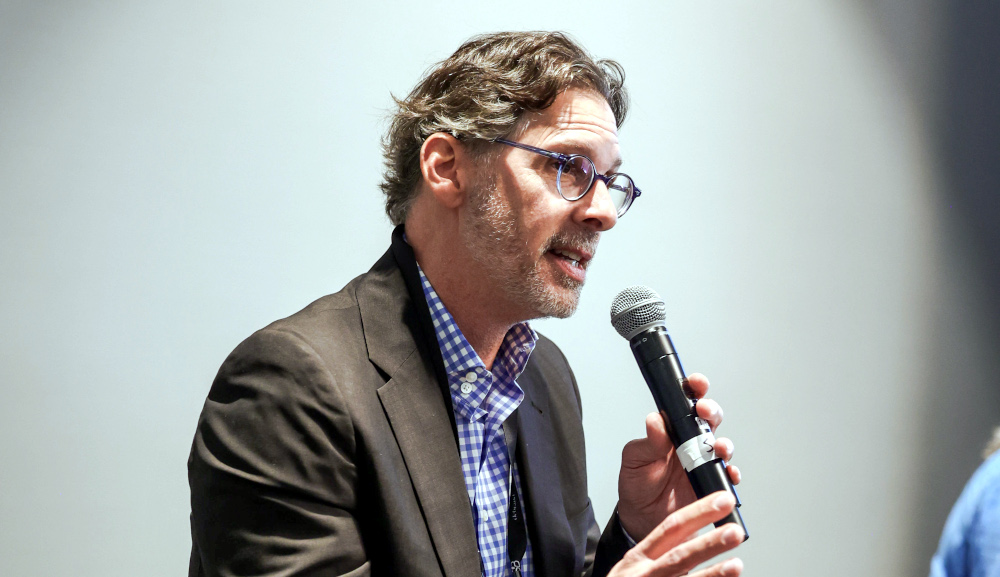 Raphael Bemporad
Raphael Bemporad
“We must recognize changes we’re experiencing as part of the human story,” said
the Summit’s host, Raphael
Bemporad — a Founding
Partner at BBMG. “We must think about the people we love
and consider what will happen to them in the future. That’s what will take us to
another place. That’s why this work matters, and why we show up.”
To give context to the stories that were about to be told, Bemporad and Earth
Guardians Executive Director Emmy
Scott referenced recent
research in which 80 percent of Gen Zers say they have directly felt the
impact of climate change in their daily life in the past year. 44 percent of
under 30s say they don’t want to have children because of the climate crisis.
The good news is that 80 percent of people say they would like to experience a
healthier and more sustainable way of living, because they feel being healthier and more sustainable improve their quality of life.
“We are dealing with problems that are not in the future; they are here right
now,” Bemporad stressed. “People are overwhelmed. They say they don’t have time,
they don’t know what the solutions are, they don’t see the options, they don’t
know what to do. They feel ambivalent and anxious.” In presenting the solutions
in a way that is accessible and desirable, “brands can become a transformative
force in society and in the world.”
Towards a resilient telecoms network and service
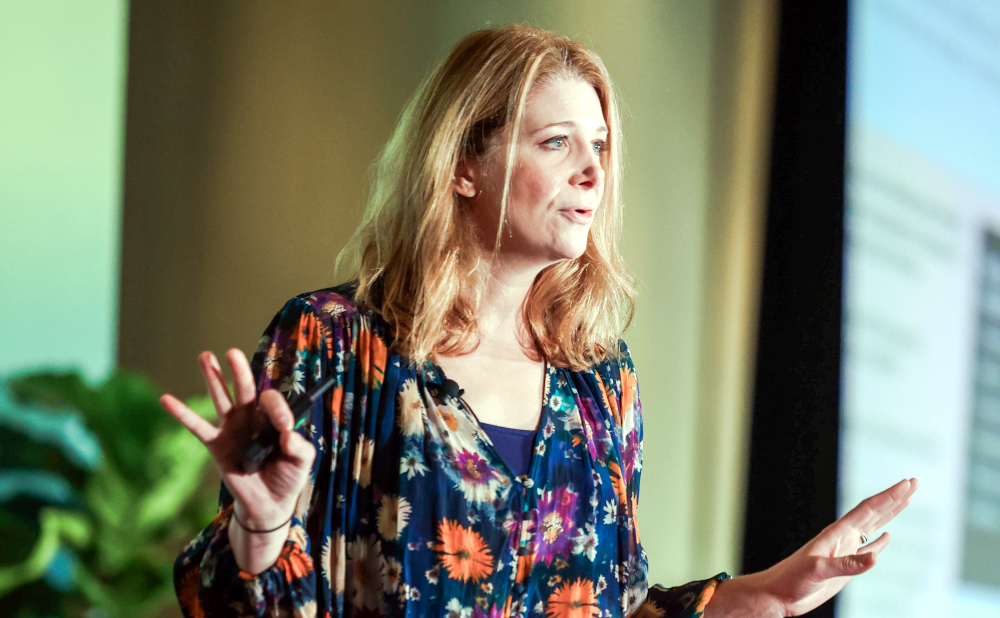 Jessica Filante Farrington, from her mainstage presentation earlier in the
day
Jessica Filante Farrington, from her mainstage presentation earlier in the
day
One company leading the charge on climate adaptation is telecoms provider
AT&T. The firm’s Director of Global Environmental
Sustainability, Jessica Filante
Farrington, began the day’s
discussions of resilience work in practice by explaining AT&T’s efforts to
translate granular climate-risk analyses into updated priorities of action
across its various internal functions and operations.
For AT&T, adaptation is about three things, Farrington said: Thinking about the
impact of climate-related extreme
weather
on the business and safeguarding its infrastructure; looking after its people
(“extreme heat impacts a lot of our guys who are working outside”); and lifting
and supporting the communities it operates within.
“I love the resilience space because it’s analogous to the role I play in my
family,” she told delegates. “I’m constantly problem solving and thinking about
the future for my children, who are 6 and 9 years old.” She is giving them the
tools they will need for tomorrow and building in preparedness that will give
them the confidence to overcome challenges — which is what AT&T is doing through
its approach to adaption, she says.
Hurricanes Maria and Harvey in 2016 and 2017 were devastating for AT&T —
costing hundreds of millions of dollars to restore networks and services — but
Farrington acknowledged it was the impetus for change internally: “That was the
moment we finally got buy in. Historical data wasn’t going to tell us about what
was to come. We needed to understand what was about to change, and we had a
chance to distinguish ourselves as a resilient network.”
One of the pivot points to Farrington’s work, she said, was piggybacking on a
team of software automation personnel who had already received investment to
overhaul their systems.
“We said, ‘While you’re at it, can we add new wireframes on climate-risk
scores?’ And we made champions of these guys,” she said. “We put them in front
of our chief sustainability officer — their work became the subject of our CSO’s
blogs. They could speak the language we needed and advocate for us.”
Understanding real estate’s climate-risk exposure
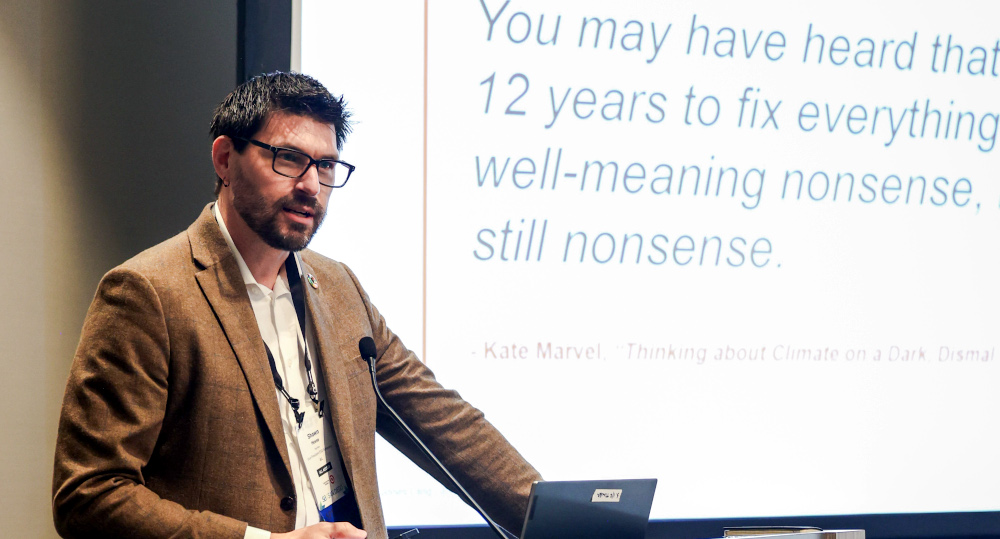 Shawn Hesse
Shawn Hesse
Supporting many of Farrington’s points, Shawn
Hesse then explained why
operational and financial risks to corporate real estate are escalating — and
what to do about it. The VP for ESG and Sustainability Advisory at
JLL took the audience through the reality — and cost
— of inaction. Climate-related impacts increase costs and insurance premiums and
cause disruption to operations. Meanwhile, energy and water costs are rising;
and increased regulation is making it harder for companies to ignore their
responsibilities.
“The truth is, there is no such thing as a climate haven,” he said. Even cities
such as Asheville, North
Carolina
— which intuitively would not be high on most people’s lists of locations of
high climate risk — have been proven unsafe. “We cannot rely on rules of thumb
or historical data to predict the future. And we can’t rely on gut.”
Instead, Hesse advocates for informed climate-risk
assessments
that consider multiple hazards across multiple time horizons. They also use
IPCC scenario planning to
give a more accurate picture of what is around the corner and just how exposed a
brand’s real estate portfolio might be.
Hesse stressed that scenario planning for climate risk should not only include
physical risks, such as the acute impact of a hurricane, or experiencing 100
days of over 100°F temperatures; companies must also consider transitional
risk — for example, how policy and regulation might impact operations or how
failure to act might impact brand reputation.
“Climate risk is a blind spot for most companies,” he added. “Just one in five
companies have a plan in place to adapt to physical risks to their
properties.
It will cost money to not prepare.”
The role of strategic foresight and backcasting in climate adaptation
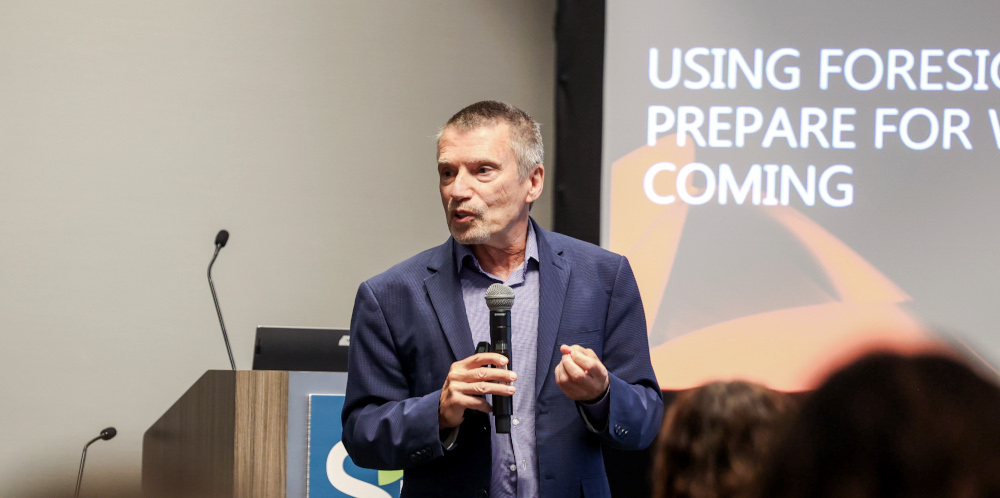 John Izzo
John Izzo
After the coffee break, purpose-driven business consultant and executive coach
Dr. John Izzo seconded the importance
of scenario planning while also highlighting
backcasting
— a business planning method of envisioning a desirable future and then working
backwards to determine how to get there — as a valuable tool for resilience
planning. Backcasting isn’t unfamiliar in business circles, but it remains
relatively — and surprisingly — under-utilized in the context of understanding
and responding to climate risks, he said.
Izzo eloquently highlighted the importance of strategic foresight and systems
thinking, and how these concepts can help humanity navigate future challenges —
especially in the context of climate change. He echoed Hesse’s point that the
future is not only about avoiding risks but also about actively working towards
a desired scenario.
One of Izzo’s central ideas is the concept that “systems eventually navigate
towards the highest images they have of themselves.” He used the Declaration
of Independence as an example: At the time it was written, the US was far
from embodying the ideals expressed in the document — with slavery widespread
and women without rights. Yet, the vision of equality and liberty set out in the
Declaration “has served as a guiding principle that the country has repeatedly
strived to live up to over the years.”
Check out more highlights from throughout the week at SB’24 San Diego!
Izzo extended the idea to the concept of foresight: “Foresight is not just about
predicting risks or scenario planning but also about asking, ‘What is the most
plausible future scenario that we want to have?’ Without a clear, desirable
future in mind, it becomes difficult to navigate the path to achieving it.”
He highlighted examples from his foresight work with organizations such as
Goldman Sachs, which prepared for Superstorm Sandy in 2012 by using
foresight to anticipate a low-probability event — a storm that flooded lower
Manhattan — and took steps to mitigate its
impact,
including stockpiling sandbags and moving their generators to the roof: “It was
one of the only buildings that had power during the storm. This is an example of
how foresight can turn small, relatively inexpensive actions into substantial
advantages when a crisis hits.”
Izzo went on to outline three potential responses to climate change that are
currently emerging:
-
The fixers, who believe we need to focus on reducing carbon emissions
and restoring
nature;
-
The adapters, who accept that climate change is inevitable and advocate
for resilience and adaptation;
-
and the 'surrender’ movement, which suggests that — since collapse is
unavoidable — the best response is to build loving, community-based
resilience in the face of the coming changes.
All three approaches are necessary, he said. “We do have to keep working to fix
it, but we’ve got to adapt.”
Climate-adaptation solutions in action
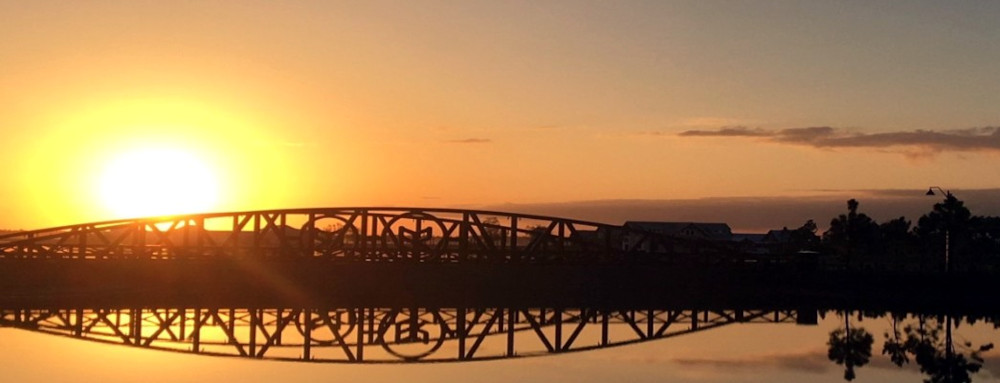 Image credit: Babcock Ranch
Image credit: Babcock Ranch
To provide more tangibility and send delegates away with more hope than anxiety,
the Resilience Summit concluded by showcasing some of the critical features that
could dominate forward-looking and resilient communities in the future.
Tyler Kitson, Senior VP of
Communities at real estate developer Kitson &
Partners, shared the philosophy behind Babcock
Ranch — the US’s first solar-powered town, and one
of the country’s largest solar-plus-battery systems. In fact, it’s
the only US town proven to withstand the impacts of a category 4
hurricane.
Surviving Hurricane Ian in 2022 established the community as an
international model for resilient design, construction and preparedness.
The town’s lakes double up as retaining ponds to protect houses from floods,
streets are designed to absorb excess rainfall, and the community hall is
reinforced as a storm shelter.
Joining Kitson was the aptly named David
Smart, Chief Commercial
Officer for BioStar Renewables — a company
that provides financing, turnkey engineering, procurement, construction and
asset management of renewable energy assets. BioStar works to give its customers maximum control over their energy consumption and costs by scaling solutions such as solar power and waste-to-energy generation through anaerobic digestion. And co-founder and CEO Aaron
Tartakovsky highlighted the work
of Epic Cleantec — a water-treatment business borne
out of the Bill and Melinda Gates Foundation’s Reinvent the Toilet
Challenge.
As he explained, the firm has become a leader in onsite water reuse, shifting
the water industry toward a distributed, circular approach in which wastewater
resources — water, nutrients, energy, carbon — are recovered and reused.
Sustainable Brands’ first-ever Resilience Summit underscored the idea that
building resilience is not just about reacting to environmental risks, but also
about envisioning and actively working toward a more sustainable and equitable
future. Resilience is not just about surviving the challenges ahead — it’s about
thriving by building systems, businesses and communities that are prepared for
the future.
Get the latest insights, trends, and innovations to help position yourself at the forefront of sustainable business leadership—delivered straight to your inbox.
Tom is founder of storytelling strategy firm Narrative Matters — which helps organizations develop content that truly engages audiences around issues of global social, environmental and economic importance. He also provides strategic editorial insight and support to help organisations – from large corporates, to NGOs – build content strategies that focus on editorial that is accessible, shareable, intelligent and conversation-driving.
Published Oct 31, 2024 8am EDT / 5am PDT / 12pm GMT / 1pm CET